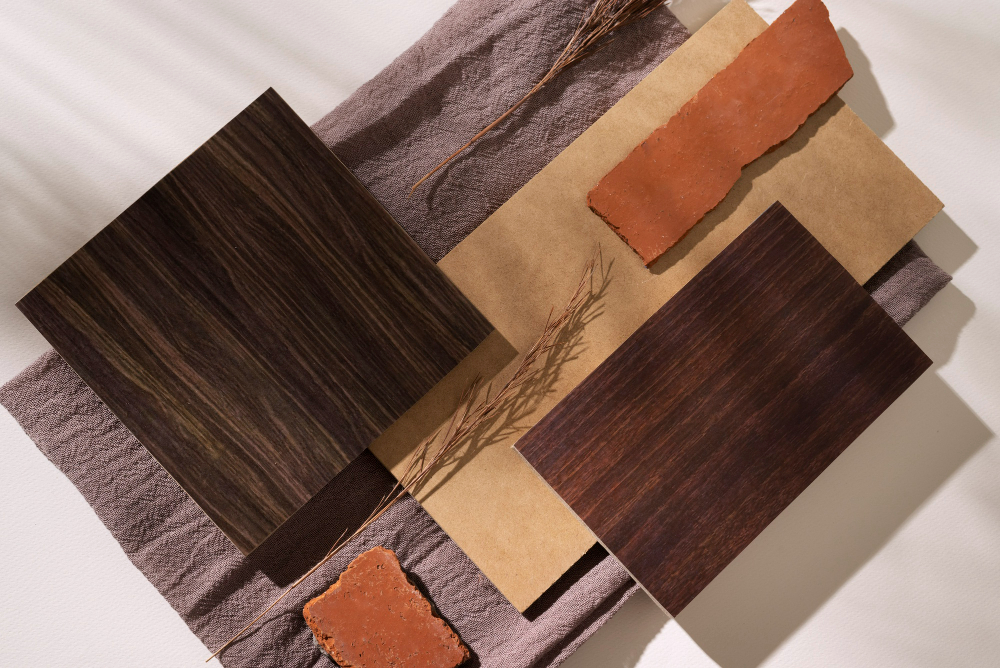Interior design is as much about furniture placement, functionality, and color schemes as it is about choosing the right materials for the project. Veneer and plywood are two popular wooden materials used in furniture, flooring, and other structural applications due to their unique characteristics and composition. While both are derived from wood, they possess distinct attributes that cater to diverse needs in the world of interior and architectural design. Let’s understand the difference between these two materials, their versatile applications, and the varied range of benefits they bring to the table.
Distinguishing Characteristics
Veneer
Veneer is a thin slice of natural wood, meticulously obtained from the outer layers of a tree trunk. Its standout feature is its ability to exhibit the intricate patterns and textures found in solid wood. Veneer comes in a variety of species such as anigre, birch, ash, and cedar, each boasting its own distinct color, grain, and character. This delicate layer is often adhered to a solid substrate, adding a touch of elegance to surfaces that would otherwise lack the natural charm of solid wood.
Plywood
On the other hand, plywood is a composite material crafted by layering multiple thin sheets of wood, known as veneers, in alternating grain orientations. These layers are bonded together with strong adhesives, forming a robust and dimensionally stable panel. Plywood’s strength and versatility stem from its layered construction, rendering it resistant to warping, cracking, and splitting.
Applications in Design and Construction
Veneer
The thin wooden sheet’s exquisite appearance and delicate nature make it a prime choice for enhancing the aesthetic appeal of various surfaces. It finds its place in creating refined furniture pieces, cabinetry, and decorative panels. Veneered surfaces lend a touch of sophistication, transforming ordinary objects into visual masterpieces. It’s worth noting that the veneer’s thinness makes it less suitable for applications requiring high structural integrity.
Plywood
This material’s robust structure makes it highly suitable for load-bearing applications in your home design. From subflooring and roofing to cabinetry and walls, plywood’s exceptional strength makes it a reliable choice in projects where stability and durability are paramount. Its versatility is further underscored by its use in creating furniture like beds, dressing tables, and sofas, where a mix of sturdiness and elegance is desired. Furthermore, specialized types of plywood, such as marine grade, cater to outdoor and water-resistant applications.
Choosing Between Veneer and Plywood for Your Project
When it comes to choosing between veneer and plywood, understanding the nuances of each material will guide you toward the perfect fit for your project’s needs. Let’s delve into the factors that should influence your decision-making process:
1. Project Type and Purpose
Consider the nature of your project. Is it primarily decorative, or does it involve structural integrity? Veneer excels in enhancing aesthetics, making it an excellent choice for furniture, cabinetry, and interior panels. If your project demands sturdiness, plywood is the go-to option for applications such as flooring, roofing, and subflooring.
2. Aesthetic Preferences
If you’re aiming for the natural beauty of wood grains and textures, a veneer can deliver stunning aesthetics with its variety of wood species and patterns. Plywood, while often used in structural applications, also offers aesthetic versatility with different finishes and veneer options that suit various design styles.
3. Budget
Budgeting is a critical factor in any project. Veneer tends to be more cost-effective in achieving a high-end appearance at a lower cost compared to solid wood. Plywood prices are typically lower than that of solid wood. It can offer substantial value for money due to its durability and longevity, potentially reducing long-term maintenance and replacement costs.
4. Environmental Considerations
Plywood can contribute to sustainable practices if sourced from suppliers that offer FSC-certified (Forest Stewardship Council) products. Veneer often utilizes thin slices of wood, allowing more efficient use of the source material.
6. Application Expertise
Understanding how to work with each material is crucial. Veneer requires finesse during installation due to its thin nature, while plywood’s strength may necessitate proper tools and techniques for cutting, shaping, and fastening.
While both veneer and plywood stem from the same source, their inherent attributes ensure they are used for slightly different purposes and applications. Whichever material you choose, it’s important to go for high-quality products that look elegant and last long. Ganpati Homez offers top-notch plywood and a wide variety of stylish veneers from leading manufacturers like CenturyPly, Greenply, and Natural Veneers. These certified products are available in a variety of sizes and styles to choose from based on your specific requirements.

